 |
 The Happy Daylily Blog - daylily pictures and thoughts from my garden
The Happy Daylily Blog - daylily pictures and thoughts from my garden

|
 March 11th, 2023 March 11th, 2023 |
After finishing dividing daylilies, garden work took somewhat of a back seat as there were many other things around the house that had been neglected and needed doing. The biggest challenge I faced was the repair of a large hole in the tool shed wall. It's been getting progressively larger for years but because I'm severely handicapped when it comes to using tools (LOL) and I'm afraid of wasps, I've been procrastinating fixing it. I was jolted into action when numerous red paper wasps started using the hole to access the shed to build their nests. These wasps are typically an inch or longer and reported to have a nasty sting which it can use multiple times. They're not supposed to be particularly aggressive but I don't believe it (did I tall you I'm afraid of wasps?).
I sprayed the ceiling of the shed with peppermint oil, which repelled the wasps last year, but they seemed to be immune to the smell this year. The solution was to spray the ceiling with Talstar P and close the door. The result was immediate. A couple hours later there were dead wasps on the floor and no more flying around. After a few days I determined that no more wasps were entering the shed even though the hole remained open. This gave me the courage to enter the shed and repair the hole in the wall.
As for the garden, all the reworked beds have a nice shredded oak leaf mulch and I'm currently removing the Oxalis and Rattlesnake weed from the one large bed that I did not dig up this year. I still have a lot of leaves to shred to cover this bed. I'll probably start shredding these early next week.
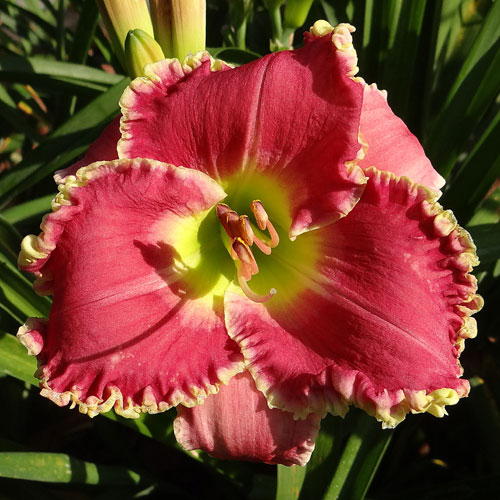
Treasure Bay (Jarvis, 2020)
Treasure Bay has 6.5" blooms on 28" scapes and comes from the cross (Running Hot × Priscilla's Smile).
|
 February 22nd, 2023 February 22nd, 2023 |
I'm happy to report that I have finished dividing daylilies and my front beds have now been replenished. I had expected to be done much earlier than this but the wet winter weather and unusual hard freeze hindered my working in the garden.
Speaking of the hard freeze, I was dividing a nice healthy looking clump and discovered the some of the internal fans in the clump had been severly damaged by the freeze. The first image below shows a couple of the crowns showing where the freeze appears to have killed off all the foliage. It turned out however, that there was still life in the crowns. The second image shows how the crowns were sending out what will be new fans from the underside of the crowns. The freeze was about 2 months ago so if you have freeze damaged daylilies, don't give up too quickly as they may come back in due time.
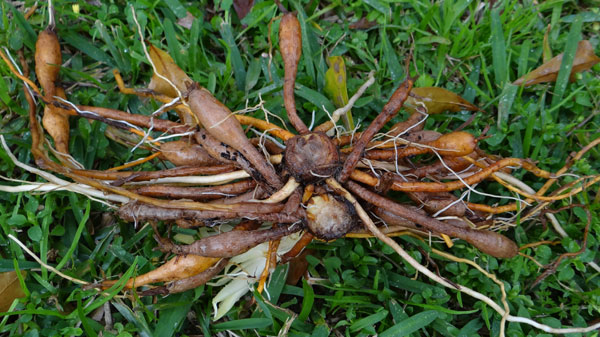
Top view
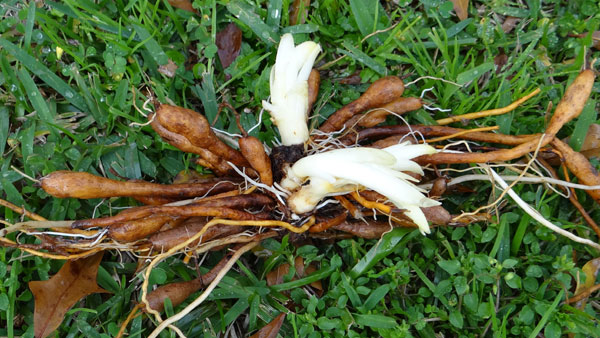
Underside view
I should also mention that I had transplanted a number of fans just prior to the hard freeze that appeared to have been killed by the freeze. I'm happy to report that about half of them have likewise put out new shoots from the underside of the crowns.
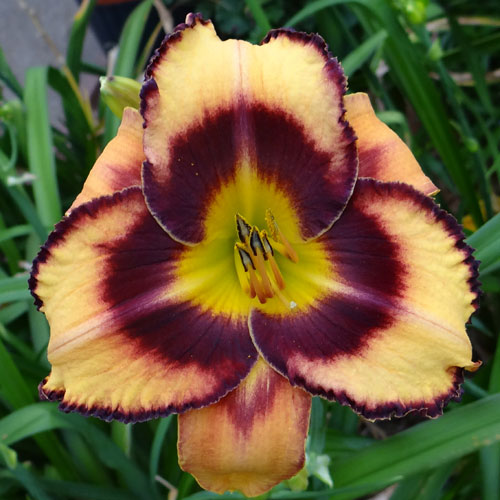
Smoky Eyed Sally (Jarvis, 2019)
Smoky Eyed Sally has 5.5" blooms on 28" scapes and comes from the cross (Goldenzelle x Bella Vita). It is a vigorous grower clumping up in as little as two years.
|
 February 16th, 2023 February 16th, 2023 |
Yesterday I finished the overhaul of the oval bed in the front yard. All the daylilies have been planted and the entire bed mulched with shredded leaves. The bed is on a slight slope so the surface water tends to drain from one side to the other. I intentionally contoured the bed surface to allow rainwater to collect in strategic spots to minimize quick runoff. Only one front yard bed remaining to be planted and that is about 1/3 completed.
One of the backyard beds is also being overhauled. It has been dug, the rattlesnake weed removed, and is probably 80% replanted. I'm now down to a single page of plants to be divided all of which are located in the one large not yet overhauled bed (a project for next year). These remaining divisions will be needed to fill the remaining front bed and the remaining spaces in this back bed.
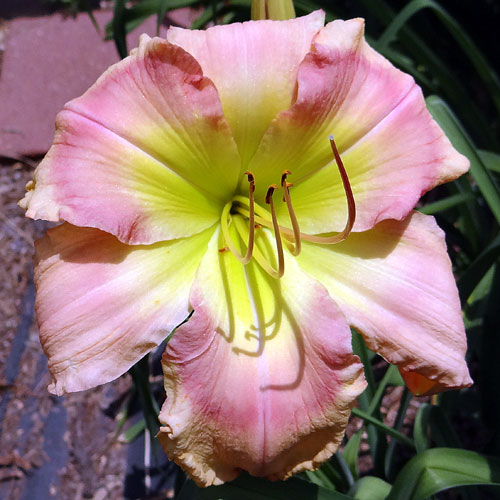
Flamingo Wings (Jarvis, 2014)
Flamingo Wings has 7.5" blooms on 40" scapes and comes from the cross ((Splendid Touch × Ed Brown) × J.T. Davis). When it first bloomed, I thought perhaps that I had written down the wrong cross info because the bloom didn't look like what I might expect from three relatively round petaled cultivars. After looking for any possible cultivar in my garden that might explain this and finding none, I decided my records were probably correct. Even a bee pollination from another garden seemed out of the question because all of the nearest daylily gardens were miles away.
|
 February 12th, 2023 February 12th, 2023 |
I decided to perform a soil structure test to see how my soil measured up using the self testing method described on the Clemson.edu website. I won't go into detail in this post but you can find the instructions here:
https://hgic.clemson.edu/factsheet/soil-texture-analysis-the-jar-test/
The process seemed simple enough. Probably the hardest part was finding a flat bottomed, straight sided jar to use for the test. In my first attempt I did something that caused the sand (bottom level) to be tilted more toward one side of the jar than the other. It was impossible to get accurate measurements so I had to start over. After that all went well. I found that my garden soil contains 65% sand, 25% silt, and 10% clay. That makes it a nice sandy loam which is an excellent mix for garden soil.
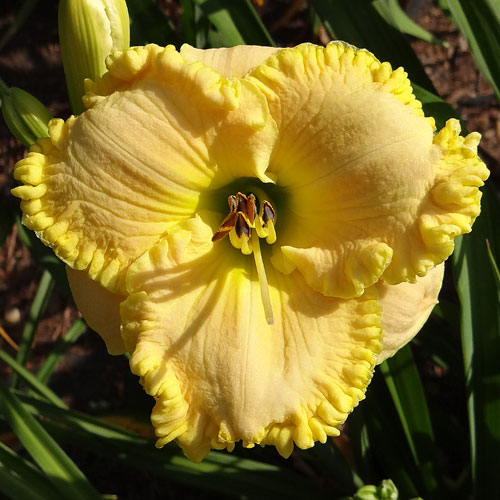
Corduroy Sunshine (Jarvis, 2020)
Corduroy Sunshine, so named because the bloom has thick substance, has 6.5" blooms on 30" scapes and comes from the cross (May I Have This Dance × Hog Heaven).
|
 January 30th, 2023 January 30th, 2023 |
When I first started growing daylilies, all my garden soil was typical for this area - gumbo. Daylilies can survive in gumbo but they certainly don't do their best. I remember reading that the way to improve gumbo soil was simple.. Amend, amend, and amend some more with compost and sharp sand in order to increase the soil's organic matter and improve the drainage. I've been doing this ever since and I recently realized just how successful I've been. I've always had a garden rule not to work the soil too soon after a heavy rain. Digging in soggy soil made sticky clods that harden when they dried. So I always would wait a few days before doing any digging.
This year, because I have so many daylilies to divide to restock the front beds, I've had to try digging as soon as 24 hours after a hard rain. Much to my surprise most soil remains workable even though it's still fairly wet. My thinking is that all the years of amending now allows the soil to drain very quickly. That's good news. However it also occurred to me that this ability to drain quickly has a negative side affect. It could mean that my normal periodic 'deep waterings' could be wasting water because much of it quickly drains through to the subsoil. So I'm going to try watering a little more frequently but for shorter times. This should keep much of the water in the daylily root zone without increasing the amount of water usage (it might even decrease it).
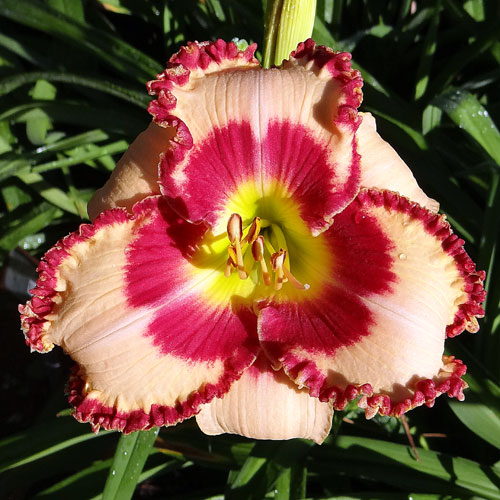
Honky Tonk Floozy (Jarvis, 2015)
Honky Tonk Floozy has 6" blooms on 29" scapes and comes from the cross (Sunshine Kisses x sdlg). The name reminds me of my grandmother. She always said that a woman with too much red lipstick looked like a 'floozy'.
|
 January 24th, 2023 January 24th, 2023 |
Most of the daylilies have put on new foliage to replace the freeze damage. It looks like a few fans here and there did succumb from the freeze. These were seedlings that had been transplanted during the week leading up to the freeze. It seldom gets this cold so I had no experience of losing in ground plants that had just been transplanted. Lesson learned... Hold off on transplanting when the weather says a polar air mass starting to move this way.
So far, I've shredded about half of the 44 bags of leaves. I set the shredder to a finer setting this year. The shredding takes a little longer but I'm pleased with the results. The smaller leaf particles should stay put better and should also attract more worms to the soil. The overall predicted weather pattern is for wetter than usual so the plan is to continue shredding on days following rain when the soil is too wet to dig.
I've started transplanting again as the daylilies are again actively growing after the freeze. I've got to get a move on if I'm going to finish dividing to fill the front beds before the warmer weather arrives. I'm fighting my perfectionist tendencies with the goal of transplanting more each day.
Oh yeah... the fence has now been replaced. It looks good but still has to be sealed and stained.
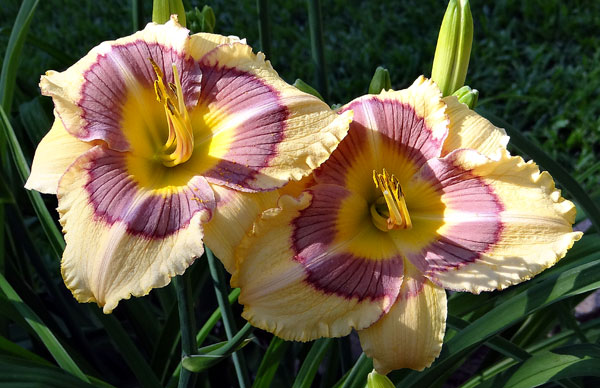
Ripples In Time (Jarvis, 2019)
Ripples In Time has 4.75" blooms on 26" scapes and comes from the cross ((Web of Intrigue x Optical Art) × Bit of Blue).
|
 January 8th, 2023 January 8th, 2023 |
The last few weeks have certainly been a wild ride and that has put me behind in replanting the front beds. It started with heavy rain about every 3 days which didn't give the soil a chance to dry enough to dig. Then there was preparing for and cleaning up after a 48-hour 15° hard freeze. Now, I have to wait a while for the daylilies to recover a little after losing all their foliage to the freeze. Life can sure be exciting!
The hard freeze had at least one benefit (I'm sure there are multiple). It gave the oak trees a good hard shaking and the leaves that were late shedding this year have now come down in large quantities. This week I picked up 44 bags of leaves just from my block alone. Next comes the shredding process to prepare for mulching the daylilies and other beds around the house. I also picked up 4 large bags which contained dried grass from someone de-thatching their lawn. I spread this 3" deep to keep down weeds in an area that will be landscaped as soon as I figure out what I want planted there. It's in the rain shadow of one of the neighbor's large oaks.
A couple of nights before the new year, a strong storm blew my backyard fence down. I knew it was just a matter of time as the fence was old and wobbly but happening now just adds to the stack of projects. No complaints however even if the "wanna do's" have to share time with the "gotta do's" (LOL).
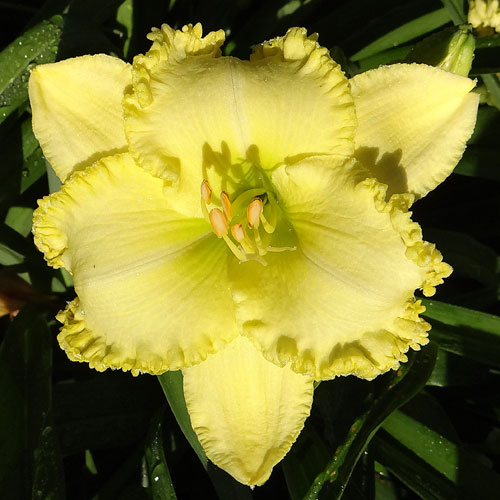
Lemon Starshine (Jarvis, 2020)
Lemon Starshine has 6" blooms on 27" scapes. It is a vigorous grower multiplying very well. It resulted from the cross (Daydream Spirit X (Caribbean Magic x Magic Attraction)).
|
 December 16th, 2022 December 16th, 2022 |
A famous hybridizer once said that to be a successful hybridizer, one had to have three things: well defined goals, a formal plan to achieve those goals, and the will to stick to the plan at least 95% of the time. He was probably talking about being a successful 'professional hybridizer' but I decided that even though I was only a 'hobby hybridizer', I needed to follow the same formula.
Because I was hybridizing on such a small scale (planting 2000 seeds per year vs. the big boys reportedly planted between 50,000 and 75,000 seeds), my goals were quite simple. Large flowers, wide ruffled petals with edging, and a variety of colors both with and without eyes. Some may be thinking that this isn't that well defined, but I was targeting a varied collection of my own registrations to have when I finally decided to retire from hybridizing.
My formal plan was to create a list of potential crosses each year. I say potential because there's no way to be sure both cultivars would actually be in bloom on the same days. First I prepared a short list of the cultivars that I would use as pollen donators (my stud cultivars). These were the cultivars in my hybridizing beds that had the very best traits that I wanted to pass on in my crosses. Then I would review all the cultivars in my hybridizing beds and select up to three crosses using the stud cultivars. This plan was created in Excel and I did it during the winter months so it would be ready to go when bloom season started.
Following the plan 95% of the time turned out to be the hardest of the three. It was amazing how many times my stud cultivars didn't have anything in the plan that was blooming that day so I could make a cross. At first it seemed like such a waste of the best pollen. I felt like I just had to make some random crosses but eventually realized that following the plan was best and the after-the-fact results proved this to be correct.
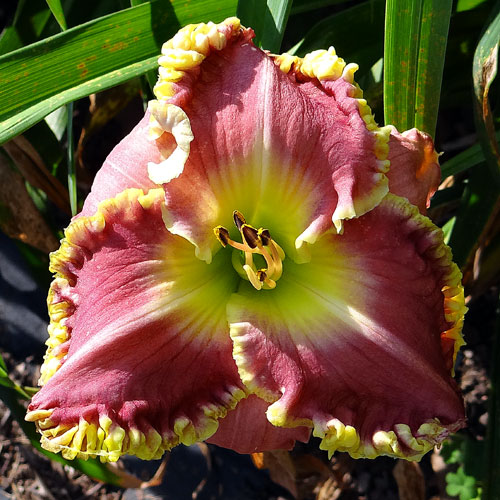
Vaudeville Man
Today's image is Vaudeville Man. It has 6" blooms on 25" scapes and comes from the cross (Cimarron Rose × Sweet Tranquility).
|
 December 11th, 2022 December 11th, 2022 |
A few days ago I did my first fall rust spraying. I used Azoxy 2SC Select (which is a code 11 fungicide) with Dithane 75DF (a code M3 contact fungicide). About 2/3 of the cultivars were not showing any rust but in some areas the rust had gotten going fairly well so I probably should have sprayed sooner. After an unusually cool and dry spell last month, more recently we've been experiencing an unusually warm and wet spell - the kind of weather that rust thrives in.
I've manually dug up two of the three front yard beds and am working on the third. The amount of tree roots found amazes me every time I dig up a bed. This year I've decided to remove only the large and medium size roots. The smaller feeder roots which have been separated from the larger roots and chopped up can remain in the soil. As they break down they should provide some needed organic matter.
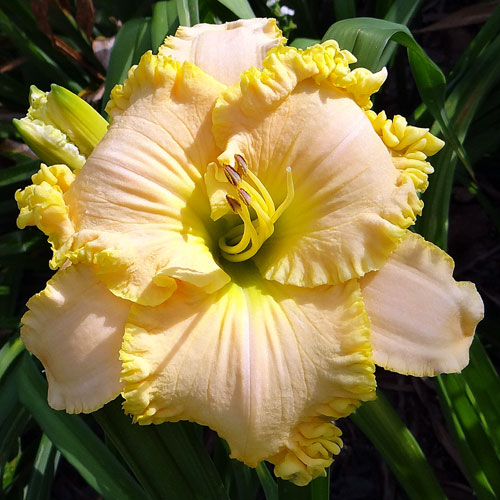
Celtic Moonglow (Jarvis, 2014)
Today's image is Celtic Moonglow. It has 6.5" blooms on 30" scapes and comes from the cross ((Victorian Lace x J.T. Davis) X May I Have This Dance).
|
 November 29th, 2022 November 29th, 2022 |
After a nice wet period where it rained a total of 5" spread over about a week (almost every other day), yesterday I was able to get back to work dividing and replanting. Even after only two dry days, the soil in the beds had drained quickly and was pleasantly workable. I have some bulk rose soil that I'm using to pot daylilies for the club that was much wetter, although also workable. This rose soil has lots of organic matter which retains moisture as well as a high sand content which provides good drainage. This reinforced the fact that I need to build up the organic matter in my garden so it will hold more moisture. This could help me to reduce the amount of watering I have to do during the hot summer.
In the early days of growing daylilies, I used to mulch with composted horse manure. This not only fertilized the soil, the abundant earth worms would eat the the manure and deposit their waste in lower portions of the soil, helping to maintain a high organic content through out the upper 8-10 inches of soil. The daylilies were incredibly healthy yielding huge scapes and high bud counts. Unfortunately the stables eventually closed, drying up my source of free aged manure. I suppose that was probably a good thing. With the manure came a huge number and variety of weed seeds which as the garden got larger became unmanageable.
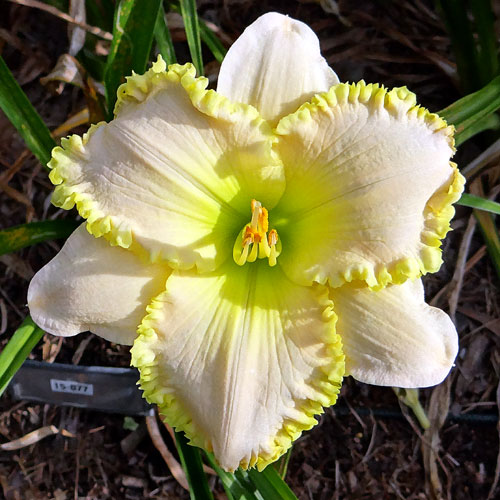
Seedling 15-077
Seedling 15-077 proves that nice things can come in small packages. The foliage is relatively small and the scapes have never been taller than 22", but the 6" off-white blooms with a slight pink blush are eye catching.
|
 November 21st, 2022 November 21st, 2022 |
I have used alfalfa pellets in the garden for years. They can be worked into the top layer of soil around each clump or just spread on the surface and covered with mulch. My favorite application is in the hole when planting the daylily. There are multiple benefits of using alfalfa in the garden. It's a balanced fertilizer with NPK of around 3-1-2 and contains minerals such as magnesium and iron. It also contains many trace elements and 16 amino acids that help keep plants healthy. Perhaps best however (IMHO) is that it contains triacontanol, a natural growth hormone that stimulates healthy roots and foliage.
Alfalfa decomposes quickly but it heats up during composition so a little caution should be used. I avoid using too much when planting (limited to a single handful per hole) and make sure the pellets are well distributed in the soil where the roots are expected to reach as they grow. I furthermore make sure that I don't place the roots directly in contact with fresh pellets as a little time is needed for them to cool down after decomposition. During warmer times of year, I limit my applications to surface spreading so any heat can dissapate into the air without affecting the roots. I apply around each clump staying around 4 to 5 inches away from the fans and cover with mulch.
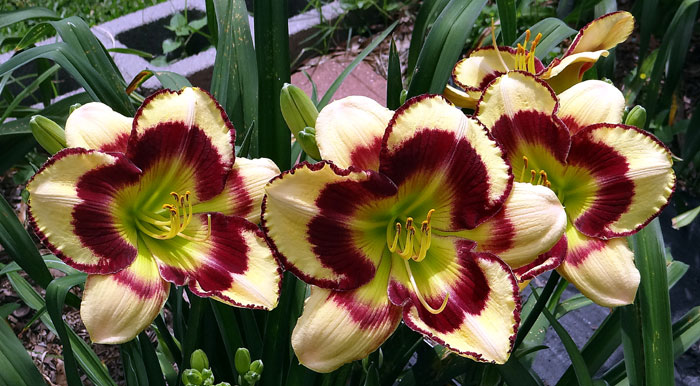
Seedling 16-138
Seedling 16-138 has 6" blooms on 26" scapes and comes from the cross (John Hawkins X Hedwig's Eyes).
|
 November 13th, 2022 November 13th, 2022 |
I am pleased to announce that I have registered 6 new daylilies for 2022.
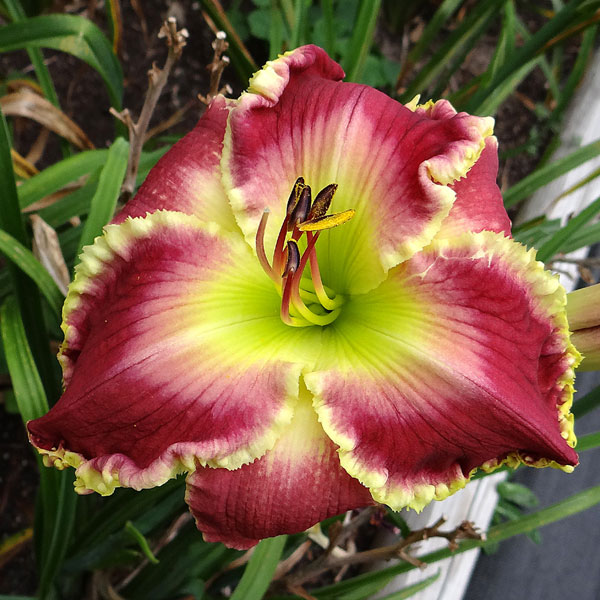
ESSENCE OF MY HEART
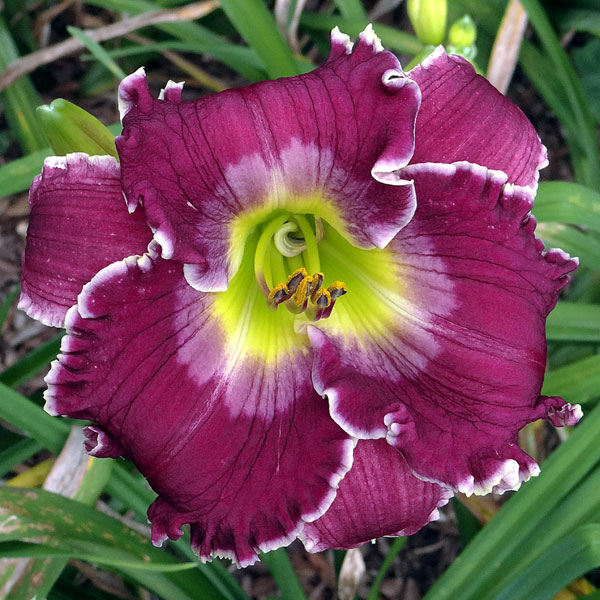
TARDY BOY
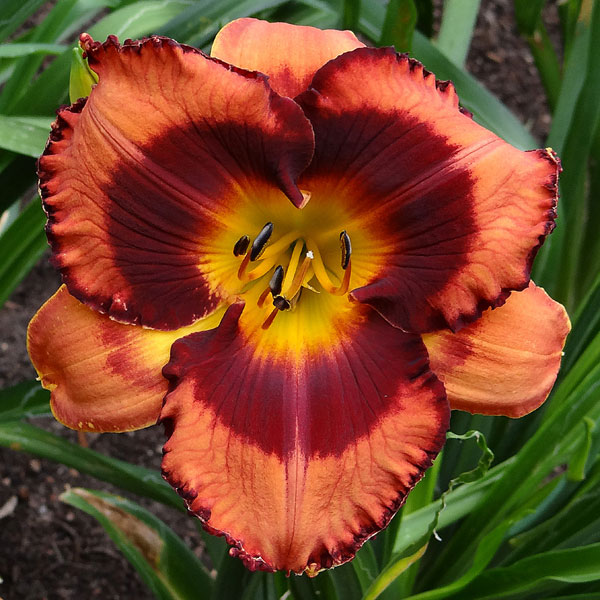
VIRAGO
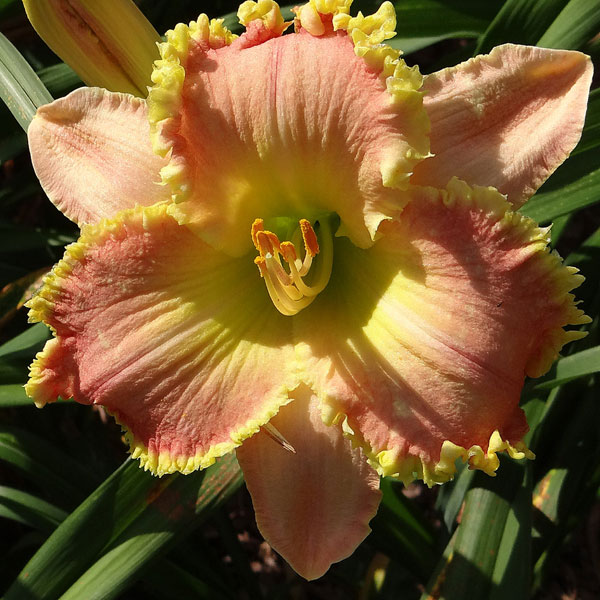
RIO SUNRISE
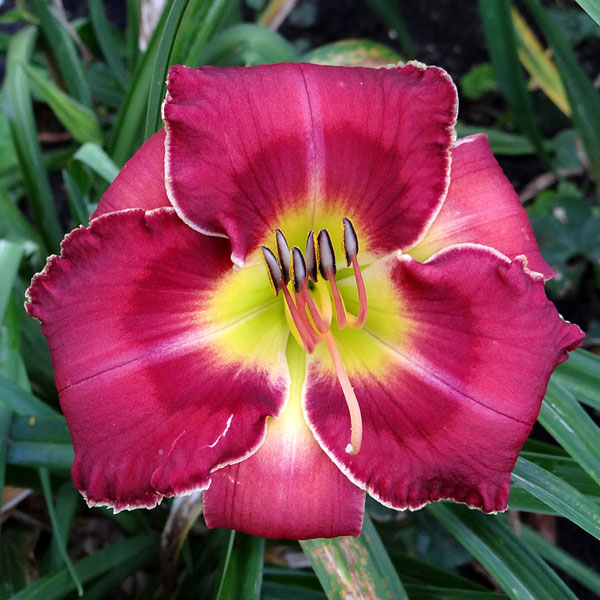
EAGERLY ANTICIPATED
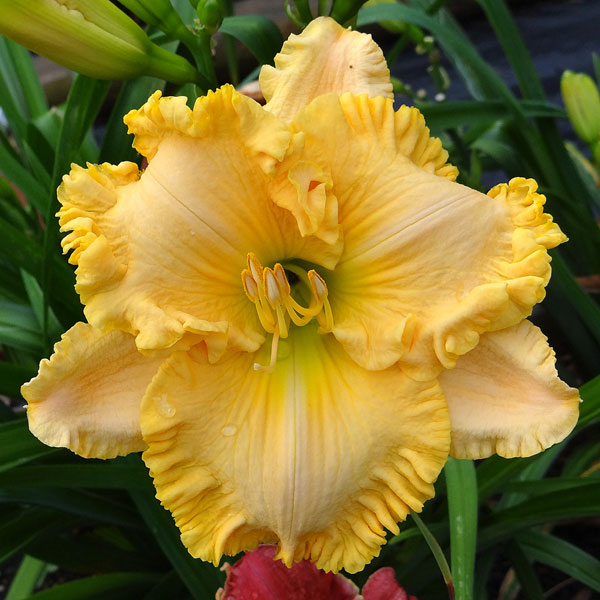
SUMMER SPIRIT
Registration details can be found on my Hemerocallis The Daylily website. Just click 'My Registrations' (upper left).
|
 November 12th, 2022 November 12th, 2022 |
It turns out that just as suspected, the back yard beds are in serious need of organic matter. The fortification of the first two rows in bed 2 has been completed and it's already about half replanted. The process involves digging, turning, breaking up the soil, and removing the tree roots. Then I add compost and work it in thoroughly. I used to do this with a large tiller but can no longer handle one and a small tiller just doesn't work deep enough. So it's been a job for shovel and hoe.
Just prior to planting, I add a handful of alfalfa pellets and small amounts of ground humate, muriate of potash, and nitrogen fertilizer to each planting hole. To avoid burning the newly planted roots, I remove some soil from the planting hole, mix the additives in the lower portion of the hole to a depth of several inches. I cover this with about an inch of soil and plant the daylilies on top, using the remaining soil I had removed to cover the roots. Probably not the best description, but the result is the plant roots rest on a layer of soil above the location of the additives. As the roots become established, they grow down to the fertilizer and alfalfa giving growth a boost. At first the daylilies grow slowly but once the roots reach the fertilized layer, there's usually a nice flush of dark green growth.
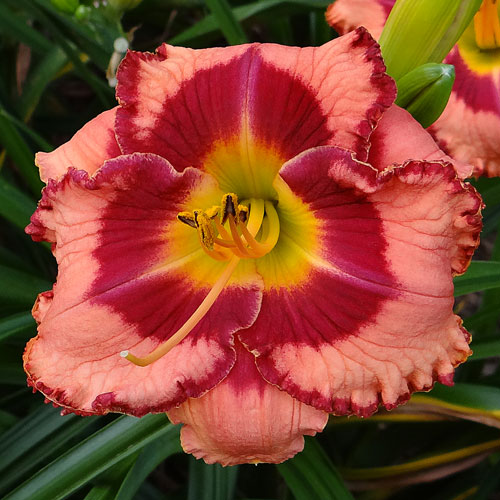
Seedling 14-013
Seedling 14-013 has 5" blooms on 23" scapes and comes from the cross (Mississippi Memento X Wild Cherry Roundup).
|
 November 9th, 2022 November 9th, 2022 |
While digging up one of my back yard beds, I've been removing many roots and tubers of the rattlesnake weed. As I've had a number of inquiries as to why it's called rattlesnake weed, I thought I'd post a picture of some of the tubers I removed today which are similar in looks to a rattlesnake rattle.
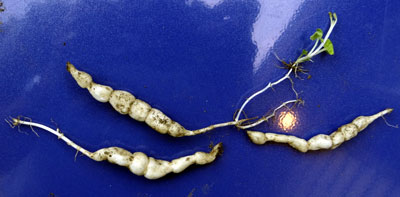
Tubers
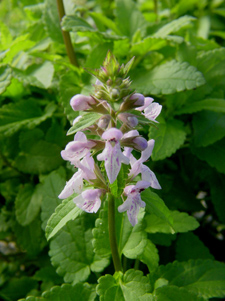
Flowers
I don't know how I got this invasive weed but best guess is that it came with some weedy horse manure or perhaps a fragment was hidden in the roots of a daylily I purchased from Florida.
Also known as Florida Betony, if left alone it will take over the bed so periodic weeding is necessary. At one point I had eliminated it from a bed but it had spread to the lawn and survived there for several years even with regular mowing. Once I removed the weed block and replanted the daylilies, it was only a matter of a couple years before it was back in the bed. The tubers are supposed to be edible but I can't confirm this (LOL).
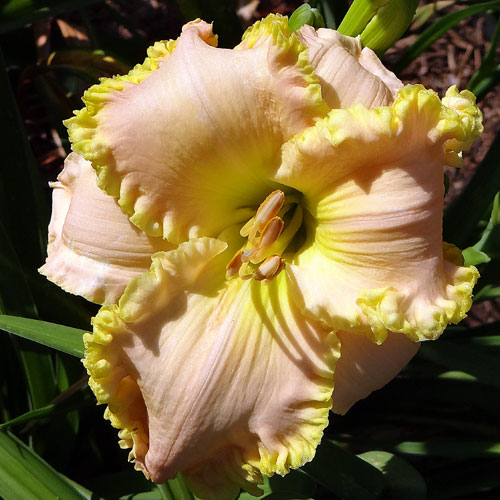
Seedling 12-078
Seedling 12-078 has 5.5" blooms on 27" scapes and comes from the cross (What Love Can Do X Sweet Tranquility).
|
 November 6th, 2022 November 6th, 2022 |
The reworking of the beds is off to a slow start - this is typical for me every year. Limited summer activity means I'm pretty much out of shape in the fall and it takes a couple of weeks of work (and cooler weather) before I really get rolling. Having completely removed so many clumps and repopulating by dividing clumps will save me quite a bit of work.
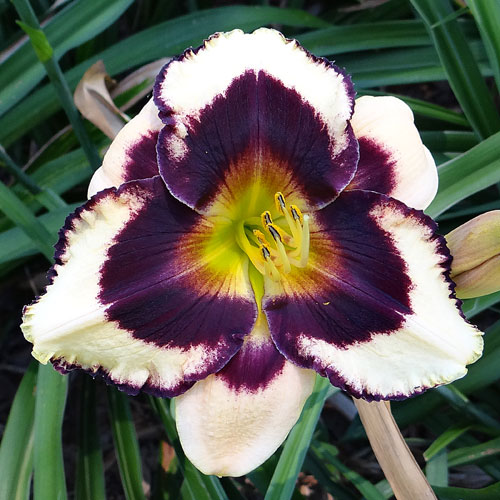
Seedling 12-017
Seedling 12-017 has 5" blooms on 24" scapes and comes from the cross (Hedwig's Eyes X Crazy Ivan).
|
 November 1st, 2022 November 1st, 2022 |
Last week I removed and tagged over 30 clumps from the front yard beds. They were donated to the Houston Hemerocallis Society for their 2023 daylily sale. I have these same cultivars growing in the back yard beds and the plan is to divide them to repopulate the front beds.
While digging, I noticed a couple of things about the soil. The first is that tree feeder roots have invaded even the beds farthest away from the neighbor's oak trees. These roots will be removed as I work in the compost prior to replanting. It's amazing just how far trees will search for food and water.
The second thing I noticed was that the soil tilth in the upper few inches is much improved since I started using shredded leaves for mulch. I had almost decided to quit using the leaves because gathering many bags and then shredding the contents was a dirty and labor intensive process. Now that I've seen what the leaves have done for the soil, I'm determined to keep on with leaf mulch.
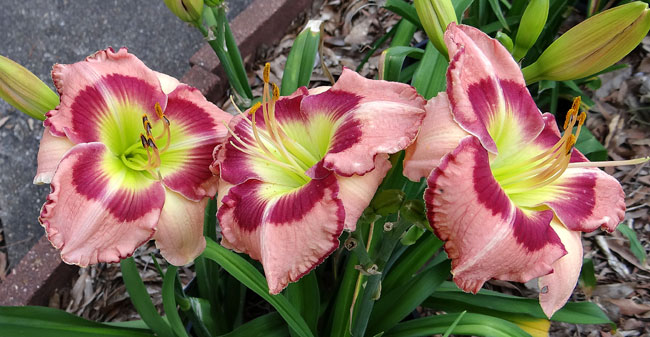
Seedling 14-001
Seedling 14-001 has 6" blooms on 22" scapes which is a little shorter than I like. It comes from the cross (Calamity Jane X Mississippi Memento).
|
 October 23rd, 2022 October 23rd, 2022 |
Garden work is progressing although slower than I'd like. I have a couple of dozen 5-gal pots with daylilies set in the ground in front yard beds. I have to grow daylilies in pots because some beds are infested with tree roots to the point where daylilies won't do well. Every couple of years I have to remove the daylilies from the pots and fortify the soil. This has enabled me to grow daylilies in beds where I can't grow them directly in the ground.
This coming week I'll be completely emptying the front yard beds so I can remove the invading tree roots and add compost. I've done this before and the results are always worth the effort as the daylilies perform really well for a few years afterwards. After reworking and fortifying the soil, the replanting will begin. I'm going to take the opportunity to reorganize the cultivars with taller scapes in the back of the beds as well as better placement of colors.
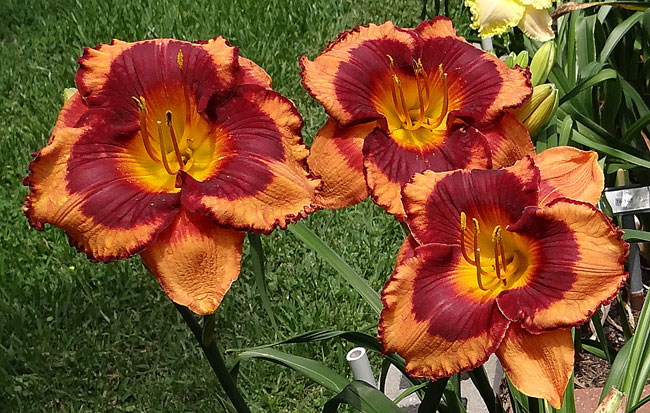
Seedling 15-018
Seedling 15-018 has 6" blooms on 30" scapes and comes from the cross (Hedwig's Eyes X Dragon Knife).
|
 October 18th, 2022 October 18th, 2022 |
It's been a while since I posted but that's not because there hasn't been anything going on. Quite the contrary as cooler weather has allowed for a flurry of gardening and general yard work. I'm going to try and catch up on the more important activities over the past weeks.
I tested the soil in several of the daylily beds. The test showed nitrogen was 'depleted' in all of them. I was expecting low nitrogen as I've been using shredded oak leaves for mulch for several years and the breakdown of the leaves uses nitrogen. I need to take this into account and apply extra nitrogen fertilizer to compensate. What really surprised me most was that potassium also showed as 'depleted'. This could be because my garden soil drains really well due to being amended regularly for over 30 years. So I need to use fertilizers with a little more potash. Other than that, the tests showed phosphorus was 'sufficient' and the pH was 'slightly acid' which is good for daylilies. The biggest lesson learned was I need to test yearly instead of every few years.
There seems to be a little more fall crown rot this year. It's not in huge numbers but is a little higher than usual. Then I noticed it was only the back yard beds and there were no losses in the front beds. This could be partly because the front bed soil is quite a bit better than the back yard soil. Yes, I'm guilty of (as the Chuck Brodsky song says) 'gotta keep the front yard looking good'. The soil in back has a lower organic matter content. The beds are larger and therefore amending them with compost is a much larger project leading to a little unintentional neglect. It could also be because the back has more tree roots than the front beds. When I dug the soil where plants had died, I found about half had died from lack of water due to a mass of feeder roots from the neighbor's trees invading the same space as the daylily roots. After rain or watering, these roots can suck the soil dry in a matter of a couple days.
Today, the first real cool front has arrived signaling the start of a major push to rework the front yard daylily beds. I've modified my plan so that one of the backyard beds will also be reworked this fall. That will allow me to complete reworking all the beds in two years instead of three.
I can remember when all my gardening was 'depending on the weather'. Now it's mostly depending on 'whether these old bones can keep up with my wishes' (smile). Regardless, I continue to have fun in my garden.
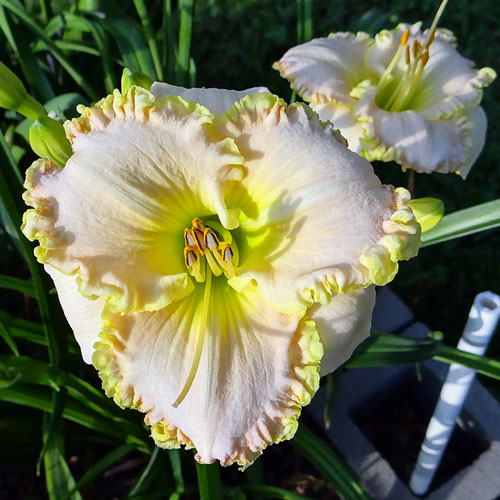
Seedling 15-048
Seedling 15-048 has 5" blooms on 27" scapes and comes from the cross (Springtime Romance X Diamond Silk).
|
 September 24th, 2022 September 24th, 2022 |
This July was unusually hot and dry which limited rebloom somewhat. Then August came with cooler temps and frequent rain. This seems to have jump started some of the rebloom scapes that may have been stifled by the July heat. This has resulted in more blooms in September than usual - not a lot mind you, but more than usual. I have a bloom open today and there are at least another 5 which should open over the next week or so. The question remains... will I have any blooms in October, very rare in my garden.
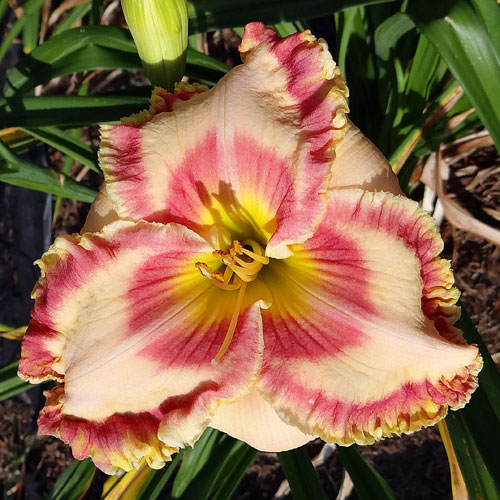
Seedling 16-092
Seedling 16-092 had a good year at least as far as 16-092 is concerned. I doubt it will ever measure up for registration with smallish plants and relatively low bud count, but I enjoy the heavy double edge. Blooms are 6" on 22" scapes. It comes from the cross (Honky Tonk Floozy X Jessica Lynn Bell).
|
 September 17th, 2022 September 17th, 2022 |
I have now purchased almost all my fall gardening supplies. The one exception is a half yard of compost, which I hope to get next week. I plan to rework all the front yard beds and will add the compost to the soil during the process.
I am in the process of reviewing the garden update plans I made during the summer to see if there are any last minute changes needed. There always are some changed needed but making an initial plan during the summer means I don't have to spend a lot of time creating a plan now that the weather is getting nicer.
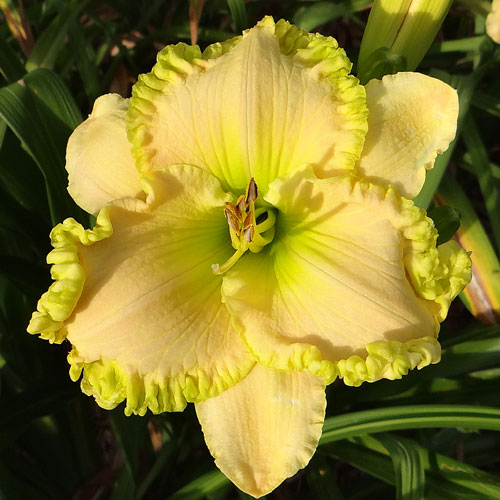
Seedling 14-073
For years, seedling 14-073 was not given the best locations in the garden. It was always a ways down in the 'keeper list' so it had been relegated to the shadier parts of the beds. A couple of years ago, I moved it to a place where it would get full sun all day. I wanted to know if the potential I was observing would develop by giving it a proper chance to thrive. It rewarded me with decent branching and bud count and the heavy braided edge showed a lot of green. It has 6" blooms on 27" scapes and comes from the cross (May I Have This Dance X Hog Heaven).
|
 September 4th, 2022 September 4th, 2022 |
The dry weather pattern has officially broken. The garden has received 3.2" of rain spread over 5 of the last 6 days. The daylilies have responded by increased new foliage growth and many are showing increase with new fans emerging. A pretty good recovery after one of the hottest and driest July's on record. There have even been some blooms in recent days - three blooms today!
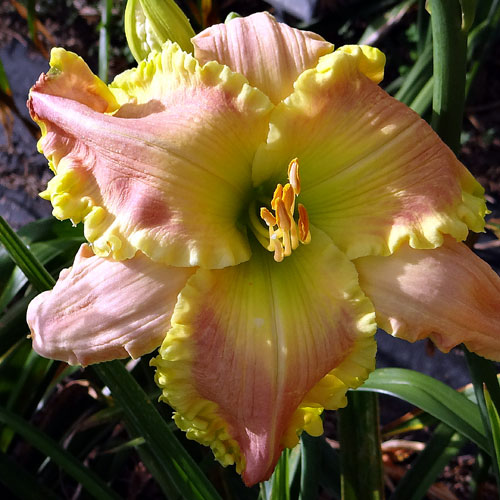
Seedling 16-065
Seedling 16-065 has 7" blooms on 28" scapes and comes from the cross (What Love Can Do X Sarah Starchak).
|
Previous Posts
|

 March 11th, 2023
March 11th, 2023 February 22nd, 2023
February 22nd, 2023 February 16th, 2023
February 16th, 2023 February 12th, 2023
February 12th, 2023 January 30th, 2023
January 30th, 2023 January 24th, 2023
January 24th, 2023 January 8th, 2023
January 8th, 2023 December 16th, 2022
December 16th, 2022 December 11th, 2022
December 11th, 2022 November 29th, 2022
November 29th, 2022 November 21st, 2022
November 21st, 2022 November 13th, 2022
November 13th, 2022 November 12th, 2022
November 12th, 2022 November 9th, 2022
November 9th, 2022 November 6th, 2022
November 6th, 2022 November 1st, 2022
November 1st, 2022 October 23rd, 2022
October 23rd, 2022 October 18th, 2022
October 18th, 2022 September 24th, 2022
September 24th, 2022 September 17th, 2022
September 17th, 2022 September 4th, 2022
September 4th, 2022




























